[NOTE: This page is presently under rather heavy development, and there are great big holes in it. I've only put it online in this state because other pages link to items on it.]
My goal here is to reprint (when possible) every published item in the literature of the pivotal type caster through the middle of the 20th century, along with references to significant later items.
Scope: I'll include both machines which were made anonymously (which is most of them, I believe) as well as those made by particular typefounders' suppliers (such as Wood, Miles & Co.) I'll exclude:
Problems: There are several problems inherent in a collection such as this.
Warning: The literature of the pivotal type caster must be read with care, because much has been written which is either incorrect or misleading. The primary example of this is the description of the so-called "discharging pin" (better called the "drag pin"), a component of the machine which is of particular interest even to non-typefounders because of the perhaps exaggerated importance placed upon pin marks by collectors of type. Nineteenth century sources tend to describe the operation of the pin correctly but incompletely. Henry Lewis Bullen changed this in his widely cited 1922 article on Bruce: his description is entirely incorrect. Unfortunately, the description of the pivotal type caster in Legros & Grant is of a different style of machine (one which does not employ a drag pin). The only complete and correct description of the operation of the pivotal typecaster published in the 19th or 20th centuries is that in John S. Carroll's brief article on pin marks in 1961. ( David Lasko's description in his 1980 article "Pin Marks, Nicks & Grooves," while correct, is too brief to be called complete.) The best account of the history and technology of the pivotal type caster, by Stephen O. Saxe, remains unpublished. (See the section Clarifying the Discharging/Drag Pin for an explanation and further discussion.)
Finally the fact that I can reasonably presume to do this at all is profoundly depressing. The pivotal type caster was one of the handful of inventions which enabled the first industrial revolution - along with the steam engine, the telegraph, the screwcutting lathe, etc. Without it there would not have been enough type to accomplish the printing required for an industrial revolution. Each of these other inventions has a substantial body of literature associated with it - both 19th century and modern. About the pivotal type caster we know almost nothing, and much of what has been said (and repeated) is wrong.
The arrangement here is - with caveats - chronological. I've also included other patents by David Bruce Jr. even if they aren't strictly related to his pivotal type casting machine. Significant items include:

Johnson. US "X-patent" 5,197X. (1828)
William M. Johnson was issued a patent for "Casting Printers' Types" on Aug. 21, 1828. All details of this patent have been lost. It has been issued the "X-patent" number 5,197X. Source: [datamp]
Writing in 1850, David Bruce Jr. said: "First among [improvements in type founding] is the introduction of machine casting, in which a pump forces the fluid metal into the mould and matrix. ... The first idea of this machine originated with Wm. M. Johnson, who obtained a patent for it in 1828." Source: [Bruce 1850], p. 401.

Bruce. (1833)
In his 1874 memoir later published as History of Typefounding in the United States , David Bruce Jr. claims that in (or near) 1833, for the firm of George Bruce & Co., "I was allowed to construct that now indispensable instrument known as the 'Force pump.'" (p. 8) He makes no mention in this 1874 memoir of Johnson's 1828 patent which, in his 1850 Report to the Commissioner of Patents, he had suggested might be a force pump.
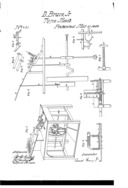
Bruce. US Patent 631. (1838)
US patent 631, "Machine for Smoothing the Sides of Type." Issued 1838-03-10 to David Bruce, Jr. of Mansfield, NJ. It is perhaps worth noting that immediately before his patent on the pivotal type casting machine (which does not produce finished types), Bruce patented a machine for one of the most laborious of type-finishing tasks: rubbing or smoothing the sides of the types. Unlike his type caster, this machine did not find acceptance in the market. It is not clear to me whether this was because of any lack of technical merit or simply because child labor is always the cheapest machine.
See also No. 5,483 (of 1848, below).
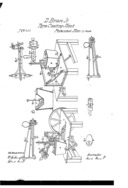
Bruce. US Patent 632. (1838)
US patent 632, "Machine for Casting Printing-Types." Issued 1838-03-17 to David Bruce, Jr. of Bordentown, NJ. (Bordentown is 4.6 miles from Mansfield)
Here's the sheet of plates (in the sadly low-resolution USPTO scan):
Here's the same image as a PDF (should that be more convenient): us-0000632-1838-03-17-machine-for-casting-printing-types-01-rot90cw.pdf
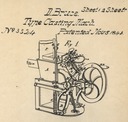
Bruce. US Patent 3,324. (1843)
US patent 3,324, "Improvement in Type-Casting Machines." Issued 1943-11-06 to David Bruce, Jr. of Williamsburg, NY.
This is the basic patent for the pivotal type caster in the form that it became successful. It lacks only a choker valve (but not all pivotals had choker valves).
Since I have images of this patent other than the low-resolution scans from the USPTO, the icon here links not to a PDF from the USPTO image but rather to a page which presents both the digital version of the patent and these analog images.

Bruce. US Patent 4,072. (1845)
US patent 4,072, "Improvement in Machines for Casting Types." Issued 1845-06-07 to David Bruce, Jr., Williamsburg, NY.

Bruce. US Patent 5,483. (1848)
US patent 5,483, "Improvement in Type-Smoothing Machines." Issued 1848-03-28 to David Bruce, Jr. of Williamsburg, NY. See also Bruce's first patent, No. 631 (of 1838, above).

Sturgis. US Patent 6,243. (1849)
US patent 6,243, "Improvement in Type-Casting Machines." Issued 1849-03-27 to John I. Sturgis but antedated to 1848-09-27. This is the invention of the choker valve. David Bruce Jr., in his 1874 History of Typefounding in the United States , credits Sturgis with priority in this invention (p. 61 of the 1981 Eckman edition).
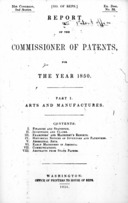
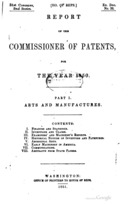
Bruce. For the Commissioner of Patents. (1850)
Bruce, David, Jr. "Type Founding" in the Report of the Commissioner of Patents for the Year 1850 (Washington, DC: Office of Printers to the House of Representatives, 1851): 398-403.
This study sheds light on Bruce's understanding of the initial application of the force pump to typecasting. In it he attributes the first use of the force pump to William M. Johnson, "who obtained a patent for it in 1828" (this would appear to be the patent now numbered as US "X-patent" 5,197X) and says that Elihu White "put it into use in his type foundry, and persevered in using and tyring to improve it as long as he lived" (but that White did not succeed in eliminating porous type). He mentions "other machines for casting printing types," but is curiously unspecific about them. Compare this to his account in his 1874 History of Typefounding in the United States , where he concentrates on his own difficulties in developing a superior force pump in 1834 and the pivotal type casting machine soon after.
This report is also important in understanding 19th century matrix production because it outlines the use of electroformed matrices from patrices for "many of the ornamental fonts and borders" (p. 401). See the CircuitousRoot Notebook on Patrix Cutting and Matrix Electroforming for a more extensive discussion of this generally misunderstood topic.
This Report has been digitized at least twice: By The Internet Archive from a wretched (but still legible) microfilm copy: https://archive.org/details/annualreport1850unit and by Google Books from the University of California copy. The two icons here link to extracts of Bruce's report from these two sources (in this order).

Silliman & Goodrich (1854)
Silliman, B., Jr. and C. R. Goodrich, eds. The World of Science, Art, and Industry Illustrated from Examples in the New-York Exhibition, 1853-54 (NY: G. P. Putnam and Company, 1854). The article on "Type Founding" from this book contains the earliest instance of which I am presently aware of the cut of a pivotal type caster which later appeared in MacKellar's American Printer and became the most common cut of this machine in 19th American century literature. The article also notes that "all, or nearly all, the types produced in America are cast by machine; the only exceptions that we know of being large, ornamental type." For a machine just over ten years old, this is an impressive accomplishment.
Digitized by Google. The icon at left links to an extract of just the Type Founding article.
Here is the cut of the pivotal caster extracted from the Google PDF as a PNG image:
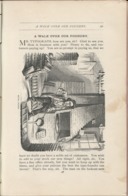
Johnson / MacKellar (late 1850s?)
Anon. "A Walk Over Our Foundry." This colloquial account of a trip to a typefoundry is best known for its appearance in Thomas MacKellar's The American Printer. The 1866 edition of this work indicates that this piece appeared originally in the Typographic Advertiser (when it was the house organ of L. Johnson & Co., predecessors to MacKellar, Smiths & Jordan). I'm not sure in which number it appeared. The Johnson foundry began publication of the Typographic Advertiser in 1855 (according to Maurice Annenberg, in Type Foundries of America and their Catalogs). Annenberg also indicates that although Lawrence Johnson died in 1860, his foundry operated under his name until around 1867. So this article might have been written at any time between 1855 and 1867.
The icon here links to an extract of "A Walk Over Our Foundry" scanned by me from my copy of the 1882 13th edition of The American Printer. It's a 43 Megabyte PDF (600dpi RGB JPEG images).
The cut of a pivotal type caster which illustrates it is the "classic" example used throughout 19th century American texts. It appeared at least as early as 1854 (in Silliman & Goodrich (1854), see above).
Here's the pivotal type caster cut itself, as an image file. It is accurate (as one would expect, given its source with the Johnson / MSJ type foundry), but it is not quite an engineering drawing. Click on the image below for a medium-resolution JPEG version.
Here's the original 1200 dpi RGB scan, as a lossless PNG (43 Megabytes): mackellar-american-printer-1882-pivotal-caster-1200rgb

Bruce. Typographic Messenger. (1867)
Bruce, David. "Type Founding in the United States." The Typographic Messenger Vol. 3, Nos 1 & 2 (November 1867 & January 1868). This was the house organ of "The United States Type Foundry"; the type foundry of James Conner's Sons. I have not yet seen it (my bibliographic reference is copied from Eckman's footnote 2 on p. viii of his edition of Bruce's History of Type Founding in the United States ). Rollo Silver, in Typefounding in America: 1787-1825 (Charlottesville, VA: University Press of Virginia, 1965), cites it as a source for information on the early type casting machine of Elihu White and William Johnson (p. 61).

Bruce. US Patent 80,448. (1868)
US patent 80,448, "Improvement in Type-Machines." Issued 1868-07-28 to David Bruce [Jr.] of Brooklyn, NY. This is for a jet-breaking mechanism applied to a pivotal caster.
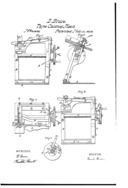
Bruce. US Patent 83,828. (1868)
US patent 83,828, "Improvement in Type-Casting Machines." Issued 1868-11-10 to David Bruce [Jr.] of Brooklyn, NY. Improvments in the cam control of the caster, and a mechanism for stopping the machine when it fails to deliver types.
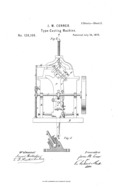
US Patent 129,106. Conner. (1872)
US patent 129,106, "Improvement in Type-Casting Machines." Issued 1872-07-16 to James M. Conner.
This patent introduces a ball joint for the lower end of what was sometimes later called the Snake Rod (as, for example, Nuernberger-Rettig p/n 91).

Ringwalt. (1871)
[TO DO: reprint excerpt] Ringwalt's American Encyclopaedia of Printing, while in general an admirable source, in the matter of pivotal type casting machines does little more than reprint an excerpt from MacKellar's American Printer.

Chambers' Encyclopædia. (1871)
Vol. 9.
[TO DO: reprint excerpt] This same image appears in Powell (1877).

Bruce. History of Typefounding. (1874, 1981)
Bruce, David, Jr. History of Typefounding in the United States. Ed. James Eckman. (NY: The Typophiles, 1981). This is a modern edition of a manuscript prepared by David Bruce, Jr. by 1874. It is in nature a personal memoir, not the comprehensive account that its title might suggest. Still, it is probably our best source for information about Bruce. It is out of print but (in this edition) in copyright, so I cannot reprint it here.
A version of this was published in 1925 by Douglas McMurtrie, but Eckman judges this edition to be a "sorry travesty" of Bruce's original manuscript.

Robinson. (1879)
A drawing by William A. Robinson. It was used in the Boston Type Foundry specimen book of 1880.

Ryan (1881)
"Illustrated Type Making" in a John Ryan specimen book of 1881. Reprinted in Annenberg's Type Foundries of America and their Catalogs (New Castle, DE: Oak Knoll Press, 1994): 224-225. This reprint is in copyright, so I can't excerpt the article here - but every typefounder should have a copy of Annenberg anyway.

Bullen, Printers' Review (1887)
Bullen, Henry Lewis. "David Bruce, Inventor of the Type Casting Machine." The Printers' Review, New Series, Vol. 2, No. 5 (Summer, 1887). [The bibliographic information here is from Eckman; I have not yet seen this piece] This journal was the house organ of Golding & Company, for whom Bullen worked at the time.
James Eckman, in his 1981 edition of Bruce's 1874 History of Typefounding in the United States , indicates that this article was reprinted in The Inland Printer in 1887 (see below) . Bullen, in his "Collectanea Typographica" column in The Inland Printer, Vol. 69, No. 1 (April, 1922): 96 says only that "in the same year [1887, he] contributed an article on the same subject [Bruce] to The Inland Printer."
The (blank) image here links to a placeholder for this article in the CircuitousRoot Henry Lewis Bullen Notebook.

Bullen, Inland Printer (1887)
[Bullen, Henry Lewis.] "David Bruce. Inventor of the Type-Casting Machine." The Inland Printer. Vol. 4, No. 12 (September 1887): 801-802. This was published anonymously, but it must have been the article that Bullen refers to in his "Collectanea Typographica" column in The Inland Printer, Vol. 69, No. 1 (April, 1922): 96.
This article contains some information by Bullen (with contradictory patent dates) and purported transcriptions of two letters by Bruce. There is no information here which is not present in Bruce's History of Typefounding in the United States , though Bruce's acknowledgment of the work of his predecessors does him credit. Eckman (p. ix) refers to Bullen's 1922 article (see below) as an "augmented" version of this piece, but they are really independent pieces.
Scanned by DMM from an original issue. The image here links to a presentation of this article in the CircuitousRoot Henry Lewis Bullen Notebook.
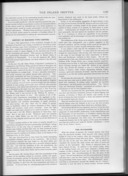
Bruce. Printers' Review. (1890)
Bruce, David. "History of Machine Type Casting." The Printers' Review New Series, Vol. 4, No. 2 (March 1890). This was the house organ of Golding & Co. I have not yet seen it in this form. This article was, however, reprinted as "History of Machine Type Casting" in The Inland Printer, Vol. 7, No. 12 (Sept. 1890): 1129. It has some information on the early work of Elihu White. It dates the first change from hand casting to 1827, and credits White with the introduction of the force pump. However, the date of 1827 squares neither with the dates for White's own work (ca. 1804-1808) nor with those for Bruce's account of his own development of the force pump (1834; see Bruce's History of Typefounding in the United States .)
The icon at left links to a PDF of a JPEG (lossy) image of this page from The Inland Printeer (10 Megabytes). Here it is as the original PNG (lossless) image (21 Megabytes): inland-printer-v07n12-1890-09-uw-0600grey-1129 Scanned by DMM from an original issue.
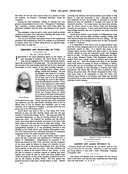
Loy, Inland Printer. (1899)
Loy, William E. "Designers and Engravers of Type: No. 14, David Bruce." The Inland Printer. Vol. 22, No. 6 (1899-03), p. 701. This is a very brief biographical sketch of David Bruce, Jr. It has little technical detail about his development of the pivotal type caster, but does give the dates for its development and patents.
The icon at left links to a reprint of this article in the CircuitousRoot Notebook on Loy, but it has also been reprinted in a extremely well produced print edition edited by Alastair M. Johnston and Stephen O. Saxe, Nineteenth-Century American Designers and Engravers of Type (New Castle, DE: Oak Knoll Books, 2009). This adds to Loy's material extensive specimens of most of the types made by the designers and engravers surveyed in the book. Anyone seriously interested in the making of type should have the Saxe/Johnston edition.

DeVinne. (1900)
DeVinne, Theodore Low. The Practice of Typography: A Treatise on the Process of Type-Making, the Point System, the Names, Sizes, Styles and Prices of Plain Printing Types . (NY: The Century Co., 1900)
Digitized by Google. The icon here links to an extract of pp. 19-27 covering the pivotal type caster and its molds.

Legros & Grant (1916): Pivotal Casters
Legros, Lucien Alphonse and John Cameron Grant. Typographical Printing Surfaces. (London: Longmans, Green & Co., 1916)
To the best of my knowledge, theirs is the only nearly-complete technical description of the operation of a pivotal caster which has ever been published. It should be noted, therefore, that it describes a style of machine without a drag pin.
Their historical account is quite Anglocentric. they quote and then deny DeVinne's attribution of the development of the caster to Bruce, claiming (without citing evidence) English priority in the "incontrovertible logic of fact" as shown in the British patent literature. They seem unaware of the theft of Bruce's invention by Brandt.

Bullen. Inland Printer. (1922)
Bullen, Henry Lewis. "David Bruce, Jr., Inventor of the First Successful Typecasting Machine." The Inland Printer, Vol. 69, No. 1 (April, 1922): 61-64.
Eckman (p. ix) refers to this 1922 article as an "augmented" version of Bullen's 1887 articles (see above), but it is really an entirely different piece.
Scanned by Google from the University of Michigan copy and available via The Hathi Trust (Hathi ID: mdp.39015086783506). The image here links to a presentation of this article in the CircuitousRoot Henry Lewis Bullen Notebook. Reprinted together with with p. 96 of the same issue, which is a part of Bullen's "Collectanea Typographica" series.
As I have been compelled to note with some frequency in various analyses of Bullen's writings, he is a dangerously unreliable source. A number of important points in his accounts of the history of type machinery are demonstrably false (and yet are still repeated as if they were true). In this present article, even though he claimed to have interviewed Bruce personally, he simply does not understand how a pivotal type casting machine works. He makes an issue about "the chief detail of the invention ... the movable discharging pin" which, he says is "projected" into the mold cavity at casting and "automatically drawn back" upon discharge. In fact the "discharging pin" (so called) on a pivotal caster (when present at all; some pivotals do not have it) is stationary - typically fixed in position by a set screw. See the section on Clarifying the Discharging/Drag Pin for more information. This article has done more damage to our understanding of the pivotal type caster (and of pin marks) than any other single source.
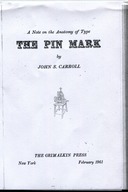
Carroll. "The Pin Mark." (1961)
Carroll, John S. "The Pin Mark: A Note on the Anatomy of Type." NY: The Grimalkin Press, 1961. Published as a part of The Second Uncommonplace Book of the New York Chappell. (NY: 1961)
This contains the only complete and correct explanation of the operation of the pivotal caster drag (discharging) pin published in the 20th century. However, his attribution of a "squirt pot" to Binny in 1811 is questionable.
My thanks to Robert and Carole Mullen, Xanadu Press, for providing me with a photocopy of this article.

Lasko. "Pin Marks, Nicks & Grooves." (1980)
Lasko, David. "Pin Marks, Nicks, & Grooves: Some Notes on the History of American Typefounding." Festina Lente: The Journal of the Melbert B. Cary, Jr. Graphic Arts Collection. Vol. 1, No. 1 (February 1980): 3-20.
This exceedingly useful article is in copyright and I cannot reprint it.
[Biblio for St. Bride's copy of Wood, Miles & Co.]
[6 ex-SB typecasters circa 2004]
[John Southward, in { Progress in Printing and the Graphic Arts during the Victorian Era . (London: Simpkin, Marshall, Hamilton, Kent and Co., Ltd., 1897.) , pp. 59-60} has this to say about the Bruce type caster and its adoption in the United Kingdom. Reprint his illustrations on pp. 59 and 61.]
The text and images from The Inland Printer reprinted here, whether from my own scans or Google's, are in the public domain. Their reprints here remain in the public domain.
The text and images of US patents are in the public domain by law.
The article by John S. Carroll was published in the US without copyright notice at a time when such notice was required to secure copyright. It therefore passed into the public domain upon initial publication. This digital reprint remains in the public domain.
All portions of this document not noted otherwise are Copyright © 2008, 2010, 2013 by David M. MacMillan and Rollande Krandall.
Circuitous Root is a Registered Trademark of David M. MacMillan and Rollande Krandall.
This work is licensed under the Creative Commons "Attribution - ShareAlike" license. See http://creativecommons.org/licenses/by-sa/3.0/ for its terms.
Presented originally by Circuitous Root®
Select Resolution: 0 [other resolutions temporarily disabled due to lack of disk space]